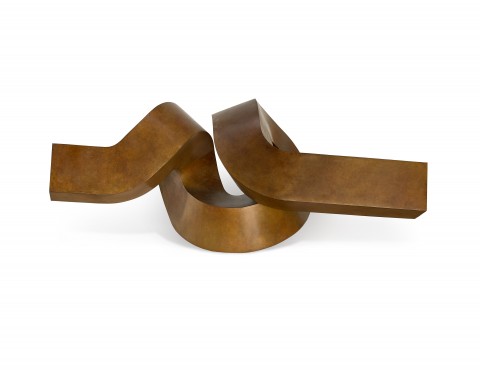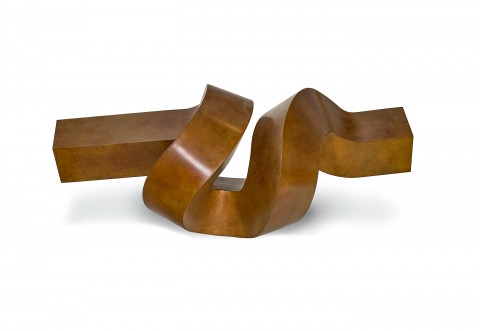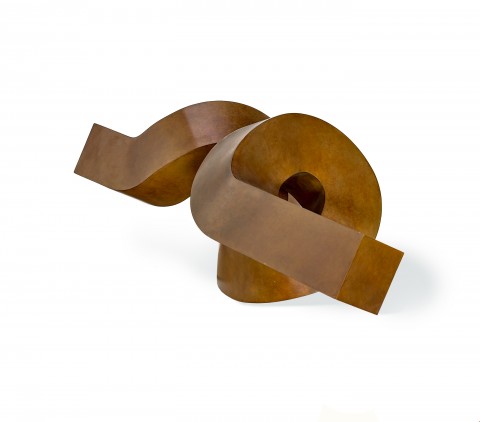RIFF, 1996
CLEMENT MEADMORE
bronze
41.0 x 100.0 x 43.0 cm
signed, dated and numbered at base: Meadmore 1996 2/4
dated, numbered and inscribed with title on base: Riff / 1996 2/4 / A. R. T.
Robin Gibson Gallery, Sydney
Private collection, Melbourne
Sotheby's, Melbourne, 17 May 2011, lot 18
John Barnes, Melbourne, acquired from the above
The Estate of John Barnes, Melbourne
Clement Meadmore: Sculptures from 1972 to 2004, Robin Gibson Gallery, Sydney, 17 November – 12 December 2007, cat. 16
Denholm, M., ‘Reviews: Clement Meadmore’, Art and Australia, vol. 35, no. 2, 1997, pp. 293 (illus., related work), 294
Riff, 1996, monumental version, in the collection of Pt Leo Estate Sculpture Park, Mornington Peninsula, Victoria
‘I am interested in geometry as a grammar which, if understood, can be used with great flexibility and expressiveness.’1
One of the most highly regarded and internationally acclaimed Australian artists of his generation, Clement Meadmore remains revered for thoughtful, impeccably executed sculptures that unify pure stark geometry with expressive gesture. Invariably constructed from one single square-sectioned beam that has been bent and coiled to the artistic aim of the artist, indeed his masterful constructions evince a seemingly implausible sense of dynamism and musical rhythm that belies their unyielding medium. Whether monumental outdoor commissions or smaller scale domestic maquettes, Meadmore’s forms typically twist, turn and writhe – their suggested animation thus adding a humanising balance to the all-too-often bland immobility and visual harshness of our modern built environments. As Gibson astutely observes, the opposition between line and mass lies at the very core of Meadmore’s sculptures: ‘…in their form they suggest the rapid motion through space of a limb or body… or the residue of such motion. They have more in common with purely aesthetic things such as a drawn line, than with a recognisable object existing in the world even though, by virtue of their sheer physical bulk and size and scale, they are undeniably that…’2
With its title no doubt inspired by the artist’s amateur musicianship and in particular, his predilection for jazz, Riff, 1996 offers a superb example of Meadmore’s constructions from his final decade during which he returned to his dense, coiled sculptures of the 1960s and early 1970s. Such free-flowing exchange of ideas within his own oeuvre was not uncommon for Meadmore, and thus the present maquette – like its large-scale version in painted steel situated in the Pt Leo Estate Sculpture Park on Victoria’s Mornington Peninsula – is strongly reminiscent of earlier works such Dervish, 1972 (Victorian Arts Centre, Melbourne) or Split-Level, 1971 (University of Houston, Texas).
Closely related to Wingspan, 1996 executed the same year, Riff nevertheless departs from these coil configurations of previous decades in its more pronounced Baroque flavour. Winding from a central access to a lateral spread with the horizontal axis parallel to the ground and the wings of the sculpture running left and right, each side in different length from the other, the sculpture holds its form and pushes into space convincingly – as so appositely intimated by its title. Evolving in an intuitive manner from a geometric vocabulary in a similar way to a Jazz improvisation, indeed the sculpture encapsulates brilliantly the musical genre of which Meadmore was such a well-known aficionado; as Gibson suggests, ‘Rhythms gather and are released – they pick up momentum and slow down, begin with sudden intensity and stop with equal abruptness. His sculptures simultaneously suggest uninterrupted flow and caesura.’3
1. Meadmore cited at: https://bluefruitdesign.blogspot.com/2012/01/clement-meadmore-not-just-s...(accessed July 2024)
2. Gibson, E., The Sculpture of Clement Meadmore, Hudson Hills Press, New York, 1994, p. 52
3. ibid., p. 57
VERONICA ANGELATOS


